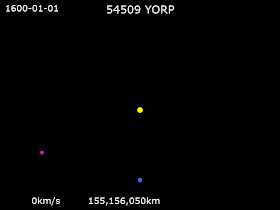54509 YORP (provisional designation 2000 PH5) is an Earth co-orbital asteroid discovered on 3 August 2000 by the Lincoln Laboratory Near-Earth Asteroid Research (LINEAR) Team at Lincoln Laboratory Experimental Test Site in Socorro, New Mexico. Measurements of the rotation rate of this object provided the first observational evidence of the YORP effect, hence the name of the asteroid. The asteroid's rate of rotation is increasing at the rate of (2.0 ± 0.2) × 10 deg/day which between 2001 and 2005 caused the asteroid to rotate about 250° further than its spin rate in 2001 would have predicted. Simulations of the asteroid suggest that it may reach a rotation period of ~20 seconds near the end of its expected lifetime, which has a 75% probability of happening within the next 35 million years. The simulations also ruled out the possibility that close encounters with the Earth have been the cause of the increased spin rate.
On 2 January 2104, asteroid YORP will pass within 0.00530 AU (793,000 km; 493,000 mi) from Earth.
YORP is the largest member of a candidate asteroid family, another member of which is 2017 FZ2, that would have been formed through shedding of fragments of YORP or the breakup of a larger progenitor due to the YORP effect.
Gallery
Animation of 54509 YORP orbit from 1600 to 2500 Relative to Sun and Earth
Relative to Sun and Earth Around Earth
Around Earth Around Sun Sun · Earth · 54509 YORP
Around Sun Sun · Earth · 54509 YORP
See also
- Horseshoe orbit
- Earth co-orbital asteroid
- 1620 Geographos
- 1862 Apollo
- 25143 Itokawa
- 2002 AA29
- 2003 YN107
- (419624)_2010_SO16
References
- Discovery Circumstances: Numbered Minor Planets
- "The Asteroid Orbital Elements Database". astorb. Lowell Observatory.
- ^ "54509 YORP". JPL Small-Body Database. Jet Propulsion Laboratory. SPK-ID: 54509. Retrieved 12 April 2016.
- ^ Taylor, Patrick A.; et al. (13 April 2007). "Spin Rate of Asteroid (54509) 2000 PH5 Increasing Due to the YORP Effect" (PDF). Science. 316 (5822): 274–277. Bibcode:2007Sci...316..274T. doi:10.1126/science.1139038. PMID 17347415. S2CID 29191700.
- Brasser, R; Innanen, K. A; Connors, M; Veillet, C; Wiegert, P; Mikkola, Seppo; Chodas, P. W (1 September 2004). "Transient co-orbital asteroids". Icarus. 171 (1): 102–109. Bibcode:2004Icar..171..102B. doi:10.1016/j.icarus.2004.04.019. ISSN 0019-1035.
- ^ Lowry, Stephen C.; et al. (13 April 2007). "Direct Detection of the Asteroidal YORP Effect" (PDF). Science. 316 (5822): 272–274. Bibcode:2007Sci...316..272L. doi:10.1126/science.1139040. PMID 17347414. S2CID 26687221. Archived from the original (PDF) on 24 July 2011.
- Matic, Otto. "JPL Close-Approach Data: 54509 YORP (2000 PH5)" (last observation: 2005-08-03; arc: 5 yr). Retrieved 18 August 2024.
- de la Fuente Marcos, Carlos; de la Fuente Marcos, Raúl (21 January 2018). "Asteroid 2017 FZ2 et al.: signs of recent mass-shedding from YORP?". Monthly Notices of the Royal Astronomical Society. 473 (3): 3434–3453. arXiv:1709.09379. Bibcode:2018MNRAS.473.3434D. doi:10.1093/mnras/stx2540.
Further reading
- Mueller, Michael (2007). "Surface Properties of Asteroids from Mid-Infrared Observations and Thermophysical Modeling". Doctoral Dissertation.
External links
- 54509 YORP at NeoDyS-2, Near Earth Objects—Dynamic Site
- 54509 YORP at ESA–space situational awareness
- 54509 YORP at the JPL Small-Body Database

| Minor planets navigator | |
|---|---|
| Small Solar System bodies | |||||||
|---|---|---|---|---|---|---|---|
| Minor planets |
| ||||||
| Comets | |||||||
| Other | |||||||

